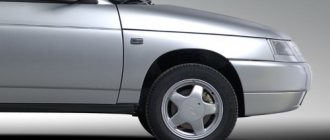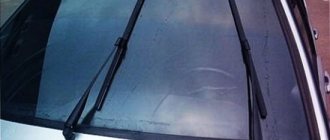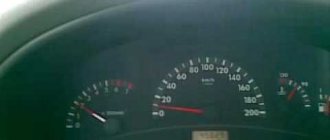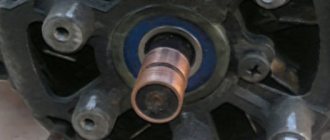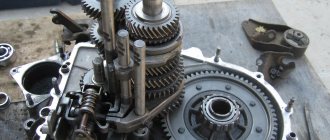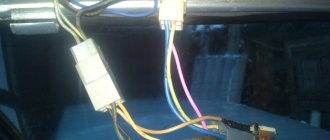Turn signals and emergency lights in combination on a VAZ-2110
Diagram of turn signals VAZ-2110.
When operating a car, its owner may encounter various system malfunctions, including failure of turn signals to work. They may either not turn on or not turn off. There are different reasons.
Verification algorithm
The driver needs to check
The steering column switch is checked by checking the contacts.
Your situation
When the turn signal does not work, and when you press the gas pedal it starts blinking, then with 99.9% confidence it is a relay.
The diagram shows the fuse box. The arrows indicate the relays and fuses for the hazard warning lights and turn signals. The VAZ-2110 may have a different mounting block.
It is located in the fuse block, number K-3.
Video “Budget option for repairing a steering column switch”
The video below presents an inexpensive option for repairing the steering column switch in a Peugeot car (the author of the video is the EzjikOnline channel).
The cause of non-functioning electrical equipment in the car (for example, fuel pump, heated seats, heated windows, power windows, etc.) may be a faulty relay. Let's look at a simple way to test a car relay for functionality with your own hands.
Connection diagram for 4 and 5 contact relays:
To check the relay you need (all relay contacts are labeled, and the power contacts usually have a yellowish tint):
- Apply 12 V voltage (for example, from a battery) to the terminals of the relay coil winding (control contacts 85 and 86).
- Measure the resistance (multimeter in ohmmeter mode) between the power terminals (30 and 87).
If the relay is working, then when voltage is applied there will be a click and the resistance will become close to zero (infinitesimal). Otherwise, the relay is faulty and must be replaced.
Feature of checking a 5-pin relay : contacts 30 and 88 must be closed, and when voltage is applied to the control contacts (85 and 86) they must open. Otherwise the relay is faulty.
The relay testing process is also presented in the video:
Let us remind you that another cause of electrical equipment malfunction in the car may be a broken wiring or short circuit. You can also determine the cause using a multimeter.
Key words: universal article
Tips for motorists
The VAZ-2110 turn indicators include six lamps located on the right and left sides of the car, two light signaling lamps on the instrument panel, a turn signal breaker relay and a fuse located in the mounting block, and controls all this under the steering switch.
The hazard warning lights work together with the direction indicators , and all wiring goes through the plug block of the hazard warning light button. Therefore, malfunctions that occur on this button also lead to failures in the direction indicators.
The most common malfunction of turn signals on a VAZ 2110 is the burnout of one of the lamps, which should have worked after it was turned on. A warning lamp will notify you of this. Its blinking frequency will increase exactly twice, which will be clearly visible to the driver who glances at the instrument panel. When replacing a burnt-out lamp, pay attention to its power; you need to replace it with exactly the same one, otherwise the light alarm will not work normally.
If the turn signals do not turn on on either the right or left side of the car. Then you will have to open the mounting block and check fuse F16. If this fuse is intact, pay attention to the relay breaker K3, it may have failed. You can check it as follows. You need to open the relay cover and, with the ignition on, bridge two contacts located perpendicular to each other using a piece of wire. If the turn signal lamps start to light without blinking, then this relay will have to be replaced, as it is faulty. But if the lamps do not light, then you will need to check the wires and plug blocks for lack of contact.
When turning on the turns, the fuse blows.
Another malfunction of the direction indicators is the fuse blowing when the indicators of one of the sides are turned on. To quickly identify a malfunction, turn on the hazard warning lights. The signal lamp in a circuit that has a short circuit will not light up or will burn at full intensity. A sign of a short circuit in the signal lamp circuit can be a buzzing sound from the turn signal relay when the indicators are turned on. To facilitate troubleshooting when the VAZ direction indicators do not work, use the diagrams below.
Reasons for failure of turn signals and emergency lights
As you know, the circuit of direction indicators and hazard warning lights is tied, since both functions are performed by the same headlights. If for some reason the hazard lights are working, but the turn signals are not, or neither the turns nor the warning lights are on, this can lead to an emergency situation on the road.
For what reasons did these elements stop working:
- Fuse failure is one of the most common problems. If the car is additionally equipped with a relay that is responsible for the operation of these optical elements, then the problem may lie there. Depending on the car model, the relay may be located separately from the main fuse block; use the diagram to find the failed part.
- Short circuit in the system. Because of this, when turning on the turning lights, the emergency lights turn on or the optics do not respond to the driver’s commands at all. To diagnose the problem, you will need a tester, as well as the skills of an electrician.
- Failure of the lighting source. In other words, the light bulb has burned out.
- Open circuit. This problem is relevant for many car owners of older cars. If the wires are laid in a place where there are moving elements, then over time it will fray and lose its insulation, which will generally lead to damage to the electrical circuit.
- Failure of a button or steering column switch. In this case, it is necessary to carry out more thorough diagnostics of the switch, as well as the connection button.
More serious problems
If it turns out that nothing happened to the fuse, then you will have to check the relay responsible for the turn signals. It is located in the mounting block in place K3. This electromagnetic breaker sometimes fails. A break in the windings or jamming of the armature may occur here.
Testing a relay is easy. Do this:
- remove the protective casing from the device;
- activate the ignition;
- close the contact group with a small piece of copper wire.
After this, leave the cabin and look at the turn signals. The relay will have to be replaced if the lights start to glow continuously. When it turns out that they are not burning at all, then it is necessary to start ringing the cables and connectors. In the latter, contact is lost very often. Sometimes the leads oxidize, and then the contact resistance increases, which provokes burning. Clean the terminals with a file, a student's eraser, or alcohol. Be sure to make sure that all wires connected to the terminals are securely fastened.
Self-diagnosis of car lighting devices
There are several situations in which you can determine that optics need diagnostics:
- The turns do not flash, but light up. Such a malfunction indicates the failure of the relay, in particular, we are talking about its electromagnetic component. The electromagnet itself could close in one of the positions, as a result of which it cannot return to its initial state.
- The turning lights flash very quickly or very slowly. In this case, the problem may lie not only in the relay. In some cases, this type of malfunction occurs when the driver uses inappropriate lighting sources. So when purchasing new light bulbs, you need to make sure that they correspond to the rating set by the car manufacturer.
- The optics don't work at all. That is, the turning light bulbs do not flicker, and the corresponding indicators on the dashboard also do not light up. In addition, there are no characteristic clicks that appear when turning on the turning lights. With such symptoms, there can be many reasons for the problem; we will tell you more about their diagnosis below (the author of the video is the Steel Horse channel).
Troubleshooting if turns do not work, even if you do not have special knowledge.
Checking the serviceability of the turn relay.
And so let’s look at what to do if the turns of a front-wheel drive VAZ, except for the 2170 Priora, do not work. The operation and troubleshooting of which was discussed in the article “Prior Turning Relay”.
First, make sure that the measuring instruments and control lamps on the instrument panel are working. If they do not work, then check the fuse.
If the devices are working properly, turn on the hazard warning button and check that all the lamps in the direction indicators are blinking. This will allow you to divide the circuit into two parts and speed up troubleshooting.
If the alarm does not work when turned on, then it is necessary to check the serviceability of the turn and alarm relay and the presence of power at its terminal 49. The pin designation is marked on the bottom of the relay, next to the contact legs.
We remove the relay, which is marked in the form of a triangle on the top of the case, from the mounting block, and in the vacated socket, using a test paw, check for the presence of a plus on pin 49. We connect the test lamp to the ground or minus of the battery, and with the other end we touch pin 49, when If the hazard warning button is on, you do not need to turn on the ignition. Lack of power indicates a faulty fuse, alarm button or broken wires, contact tracks of the mounting block and poor contact in the connectors.
If there is a plus on the terminal, then connect terminals 49 and 49A with a copper wire. If the connecting wires and connectors are in good condition, all the direction indicator lamps should light up. This indicates that the turn signal and light signaling relay is faulty. If the lamps do not light up, but there is a plus on pin 49, then there may be a short circuit in the signal lamp circuit and the fuse has blown. A short circuit can also cause the relay to fail. In this case, check the serviceability of the fuse, and if it blows, eliminate the short circuit in the signal lamp circuit.
Checking the hazard warning button.
If the hazard warning lights are working, then the turn signal and hazard warning relays are working properly, but the fault may be in the hazard warning light button. First, check the plus, as described earlier at pin 49 of the relay, with the hazard warning button off and the ignition on.
If there is no plus, then you need to check the serviceability of the alarm button. To do this, you need to remove the button from the socket by prying it off with a thin screwdriver or remove the instrument panel visor. In the contact connector of the button, use a test lamp to check the presence of power at pin 2 (the numbering of pins on the button near the contacts) with the ignition on. If there is no power, repair the broken wire from the instrument panel to the button. If there is power, connect pin 2 to pin 5 in the button socket, with the ignition on, and turn on the direction indicators of either side. If the warning lights on this board light up, replace the faulty hazard warning button.
If the warning lights do not light up, then, without removing the jumper from the hazard warning button block, connect pins 49 and 49A with a copper wire in the relay socket, then check the power at pin 49A of the turn switch. To do this, remove the steering column cover and the connecting connector from the turn switch. You can also remove the switch itself to determine the pin numbers that are marked on its lower part next to the contact legs. This is not difficult to do by squeezing the latches on the sides of the switch and pulling it to the side. If the circuit from the relay to the switch is in good condition, the indicator lamp will start to light. If the control lamp does not light, then repair the break in the wire from the mounting block to the turn signal connector.
Do-it-yourself repair of direction indicators and hazard alarms
If the turns disappear, as well as the car’s emergency signal, then you can try to solve this problem yourself:
- If the safety element and relay break down, the failed parts must be replaced. If the reason lies in a short circuit, then before replacing it is necessary to check all electrical circuits in which it could occur. Only after the cause of the short circuit and power surges has been eliminated, the devices need to be changed.
- If the hazard warning button is faulty, you just need to replace it. We have already talked about how to diagnose this part.
- As for electrical circuit diagnostics, it is carried out using a tester. If damaged sections of the wire are identified, they must be replaced. When laying them, make sure that the wiring does not come into contact with moving body elements. It is also recommended to additionally insulate new wires to increase the reliability of the insulation.
- If the reason is the light bulbs, then all burnt out light sources must be replaced. In the front and rear headlights, the lamps are changed by removing the protection from the headlights, disconnecting the power circuit from the lamp, as well as unscrewing the light source from the seat and replacing it with a new one. If the lamps in the side headlights do not work, then, as a rule, to dismantle the lighting sources, the lamp itself must be pryed off with a screwdriver, then disconnect the power cord and remove the device.
- If the reason lies in the steering column switch, then this device needs to be disassembled and checked. As a rule, the cause of switch failure is poor contact or abrasion. In this case, the failed switch is replaced with a new one. As for the contacts (no matter where - on connections or buttons), it is advisable to clean them.
- You should also check all the plugs and connectors, because it is quite possible that the problem is poor contact on them. Acidified contacts must be cleaned with a wire brush or sandpaper. If the contacts are burnt out, they will need to be replaced.
Controls
Not too often, the reason that prevents the turn signals from working is the steering column switch.
In this case, there are usually no problems with emergency lights. To check its serviceability, you will have to suffer a little. First of all, remove the casing covering the steering column. Here you will find a connector that connects the wires leading to the switch. The blue and red cables must be connected directly. Simply unplug the block and insert a jumper (such as tweezers) into the corresponding terminals.
Next, get out of the cabin and see if the turn signal is working properly. If yes, then you will have to change the switch; failures in it are usually purely mechanical and it is unrealistic to eliminate them - the design does not provide for it. When nothing happens, look further.
In general, there are only two versions left to explain why the turn signal does not work:
- break in the wiring;
- hazard warning button failure.
To check the cables, you need to remove the negative terminal from the battery. Next, starting from the switch, all the veins are inspected (and simultaneously tested with a multimeter). Insulation damage and breaks are repaired. It is advisable to replace unusable sections with a new intact wire, since otherwise the risk of repeated failure cannot be completely eliminated.
Messages 16
1 Topic by AMORAL 2015-10-28 17:40:10
- AMORAL
- New member
- Inactive
- From: Tula
- Registration: 2014-01-25
- Messages: 46 Thanks : 3
- Auto: 2112
Topic: Front right turn signal does not work, there is voltage, I changed the lamp
Hi all! Maybe a trivial problem, but still. Background, at first the right side began to blink rapidly, but all three turn signals worked. A week later the front one, which is in the headlight, stopped working. The voltage was measured - yes. The light bulb is normal, but just in case I bought a new one, nothing has changed. Complete stupor, I don’t know where to dig, because I expected that there was no voltage. Maybe someone has encountered this and can give some good advice?
2 Reply from Slag 2015-10-28 19:28:04
- Slag
- Participant
- Inactive
- From: Dnepropetrovsk
- Registration: 2014-04-23
- Messages: 146 Thanks : 43
- Car: 2111 1.5 16kl. 2002
Re: The front right turn signal does not work, there is voltage, I changed the lamp
Accelerated blinking of the turn signals means the resistance in the circuit has dropped. If all the lamps are working, then it is worth looking at the lamp bases and lamp seats for contact oxidation. There is contact, but not sufficient.. Perhaps the contact under the lamp in the headlight has oxidized..
3 Reply from AMORAL 2015-10-29 00:20:47
- AMORAL
- New member
- Inactive
- From: Tula
- Registration: 2014-01-25
- Messages: 46 Thanks : 3
- Auto: 2112
Re: The front right turn signal does not work, there is voltage, I changed the lamp
Accelerated blinking of the turn signals means the resistance in the circuit has dropped. If all the lamps are working, then it is worth looking at the lamp bases and lamp seats for contact oxidation. There is contact, but not sufficient.. Perhaps the contact under the lamp in the headlight has oxidized..
There were no visible oxides, but just in case I cleaned everything up, there were no changes. PS There are LED lights installed at the rear, could something like this start due to them? But, I repeat, only the right front turn signal does not work.
4 Reply from kosmos 2015-10-29 03:50:51
- cosmos
- Blocked
- Inactive
- Registration: 2014-05-17
- Posts: 2,021 Thanks : 406
- Auto: 2111 - 1.5 -16v
Re: The front right turn signal does not work, there is voltage, I changed the lamp
There were no visible oxides, but just in case I cleaned everything up, there were no changes.
Have you tried changing your contacts? There is voltage, but the contact does not reach the lamp.
There are LED lights at the rear, could they cause something like this?
Maybe this is the reason for the rapid blinking, but the turn signal should be on! There's just no contact.
5 Reply from AMORAL 2015-10-30 01:32:50
- AMORAL
- New member
- Inactive
- From: Tula
- Registration: 2014-01-25
- Messages: 46 Thanks : 3
- Auto: 2112
Re: The front right turn signal does not work, there is voltage, I changed the lamp
There were no visible oxides, but just in case I cleaned everything up, there were no changes.
Have you tried changing your contacts? There is voltage, but the contact does not reach the lamp.
There are LED lights at the rear, could they cause something like this?
Maybe this is the reason for the rapid blinking, but the turn signal should be on! There's just no contact.
Podginal. I'm already scratching my head about what the reason is. Friends are also shocked how this can happen. Everyone says that they have never encountered anything like this. That's why I decided to write here
As for the LED lights, I’ve had them installed for about half a year, before that everything was ok, and only one side started blinking - the right side. And then the right front turn signal stopped working. Everything is fine with the left side, it blinks as it should. Some kind of mysticism.
6 Reply from klimashov.roman 2015-10-30 08:15:23
- klimashov.roman
- Connoisseur
- Inactive
- From: Kasimov
- Registration: 2014-04-21
- Messages: 743 Thanks : 143
- Car: GAZelle 33023 dv 405.22, 2.4 16kl 140hp
Re: The front right turn signal does not work, there is voltage, I changed the lamp
Maybe you should look towards the turn switch, there are no oxides there
7 Reply from Slag 2015-10-30 10:01:18
- Slag
- Participant
- Inactive
- From: Dnepropetrovsk
- Registration: 2014-04-23
- Messages: 146 Thanks : 43
- Car: 2111 1.5 16kl. 2002
Re: The front right turn signal does not work, there is voltage, I changed the lamp
And in the emergency light button, it seems like the chain of all the turn signals goes through it...
8 Reply from AMORAL 2015-10-31 12:39:32
- AMORAL
- New member
- Inactive
- From: Tula
- Registration: 2014-01-25
- Messages: 46 Thanks : 3
- Auto: 2112
Installation process
Before you understand how to connect the turn signals to the side lights, please note that the optics of the side lights have two main colors:
- Yellow (“American”) merges with the same color of rotating optics;
- White with a yellow twist is better to stand out on the road.
Side lights are inserted into the vehicle's turn signals as follows:
- In the rotating optics on the VAZ, cut a hole where the cartridge will be inserted. It is acceptable to use a w5w cartridge. It will be inserted into a standard 5W incandescent lamp or LED strip;
- Secure the cartridge into the optic for rotation to prevent moisture, dirt and prolonged attachment;
- To transfer the lighting from the headlights to a VAZ 2107 or 2109, switch the wires to the newly installed cartridge. When connecting additional lamps without a transmission, it is necessary to close the contact in the block leading to the headlight in parallel.
READ Engine Troubles And Kalina Check Flashes
After such modifications, the car acquires a special charm.
Please also note that if you install lighting fixtures on the front of your vehicle that are equipped with red lights or reflectors, or bulbs that are not functioning properly and are of a color that is against the law, you will be subject to a fine of the following amounts:
- 2500 rubles if you are a civilian;
- 15,000-20,000 rubles. Official;
- 40,000. 50,000 rubles. Legally.
Recently, motorists have managed to equip the side lights in the corners with bulbs with two contacts. But this measure may also interfere with other road users. So, controlling your headlights, no matter how useful they may be, can reduce your safety. So don’t be surprised by the growing attention to your car from the traffic police.
Source
Electrical equipment malfunctions may occur during vehicle operation. One of these troubles is a failure of the turn system, usually through the indicator relay. We will try to look at what the turn signal system consists of, the most common faults and answer the question of what to do if the turn signals do not work.
Traffic indicators are an integral part of road safety.
Using them allows drivers to know your intentions, make the right decisions and maneuver wisely. The first turn signals appeared in the form of special arrows, turned on by a special mechanism and indicating the direction of movement of the car. After this, the system was improved, and instead of primitive signs and symbols, the first lamps appeared, which made the driver’s work easier and distracted him less from driving. The turn signals that we are used to seeing appeared in the 30s of the last century and were used in the form of special lamps located on the fenders or bumper of the car. Over time, it has become an indispensable component of any car and its serviceability must be fully preserved.

